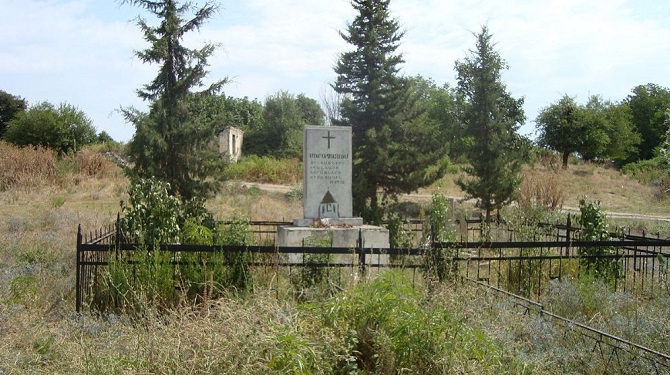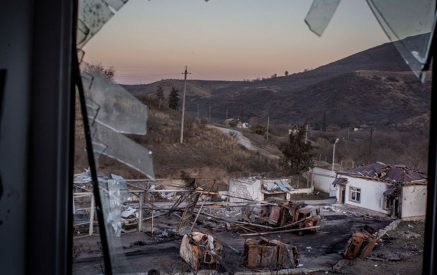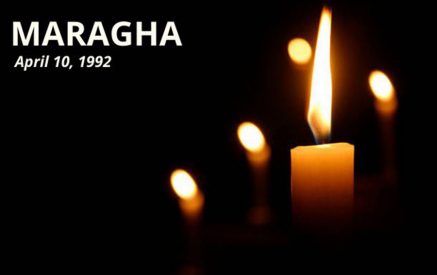The Armenian Weekly. April 10 marks the 28th anniversary of the Maragha Massacre, one of the most frightful pogroms committed by the Azerbaijani military against peaceful Armenian inhabitants during the Artsakh Liberation War.
Maragha was one of the largest and richest villages in Artsakh before the war; several factories operated, and viticulture was developed in the village. After the pogroms in Baku, Sumgait and Kirovabad, attacks on the civilian Armenian population were highly increased in scope, forcing most of the locals to leave their native villages. On April 10 of 1992, Azerbaijani Defense Ministry, Internal Affairs Ministry and OMON forces (Special Purpose Police Units of the Ministry of Internal Affairs of Azerbaijan) launched an attack on 118 civilians who were unable to leave Maragha. Within a span of roughly five to six hours, Azerbaijani units brutally killed about 50 people and took almost as many civilians as hostages with 29 women, nine children and disabled people among them. Subsequently, it became possible to rescue some of these people, including all the children, yet the fate of 19 hostages remains unknown.
The village of Maragha was located in the Martakert region of Nagorno Karabakh, just across the border from the Azerbaijani town of Terter (Mir-Bashir) and was one of the region’s largest villages. According to the census of 1989, the village had a population of more than 5,000 people, predominantly ethnic Armenians including a few Armenian families who escaped pogroms and were forcefully deported from Sumgait, Baku, and other areas of Soviet Azerbaijan. Beginning in 1954, Maragha and a village named Margushevan located in the vicinity of Maragha were united together under one state farm (sovkhoz) which was named Leninavan (“Lenin’s town”).
After the start of the Karabakh Movement, the tension in Maragha greatly increased; the village was under constant shelling and the civilians were in a state of fear because of the attacks towards their properties and cattle, as well as themselves and their families. Azerbaijan tightened the blockade which it had imposed on Nagorno-Karabakh for about two years, at the same time employing a policy of ethnic cleansing and military assaults against the Armenians in Karabakh. Maragha and the neighboring villages were systematically raided by Azerbaijani armed forces. In the aftermath, some of the residents of the village had to leave their houses and temporarily settle in other regions of Artsakh. Those who chose to stay had a clear perception that the only way to survive was to organize self-defense.
Read also
The Maragha self-defense
The self-defense units’ members, who were mostly the locals of Maragha and the surrounding villages, set up four defense positions around the village while the residents built underground shelters. According to the commander of the self-defense unit Roma Karapetyan, the first attack took place on February 25 and 26, 1992 and received a proper counterattack. But the situation changed in April when the offensives started to be guided by Azerbaijani Defense Ministry forces.
On April 10, 1992 the Defense Ministry Units of Azerbaijan, along with the units of the Internal Affairs Ministry and the OMON forces, attacked the village three times in a row without any success. The main attack on Maragha was carried out by not only a manifold but also many armored vehicles, including tanks. The self-defense units had to retreat as they did not have appropriate military equipment to deliver a counterattack.
Within a few hours, Azerbaijani military forces destroyed and burned the houses, practically razed everything to the ground, brutally tortured peaceful civilians to death, some burnt alive, dismembered and mutilated without discrimination, and captured many locals, mostly elderly, women and children taken to unknown locations.
“Among the streets, one out of every 10 people had swords in their hands. At that time, I ordered the guys to shoot the ones carrying swords with them. Then it turned out that some of the other volunteers had also heeded the same thing in the other parts of the village”, recalls Roma Karapetyan. Later, as Karapetyan says, they found bodies of civilians with Christian cross marks made by those swords.
Karapetyan says that their main goal was to liberate the village before dawn as they clearly understood that the more they waited, the more innocent civilians were going to be tortured by Azerbaijanis. They received help from the other self-defense units fighting in the surrounding area. Despite the lack of sight, arms and people, the Maragha liberation plan was completed successfully. It is worth mentioning that Leonig Azgaldyan and Vladimir Balayan were among the volunteers of the assistance group. Both posthumously received Artsakh Hero awards in 2019. Roma Karapetyan says Azerbaijan had 44 losses while there were none from the Armenian side.
The Golgotha of the 20th century
“I, along with my team from Christian Solidarity Worldwide, arrived within hours to find homes still smoldering, decapitated corpses, charred human remains, and survivors in shock. This was truly like a contemporary Golgotha many times over,” writes Baroness Cox of Queensbury, a defender of human rights in the House of Lords, United Kingdom.
According to eyewitness accounts, people were decapitated, tortured (being dragged tied to a tank or burnt alive), bodies were mutilated, dissected and burnt. Karine Poghosyan was taken captive along with her two infants and her father-in-law. “They were swearing at Armenians. They said that we are Armenians, and we are haram [indecent]. They looked down on us with hatred and with a feeling of disgust,” says Poghosyan, recalling those days in captivity. Some of the Armenian captives were later exchanged but many of them did not have any information about their families. Poghosyan was one of those – she had no idea where her daughter was being kept. Only after the exchange, the child was found in an orphanage in Azerbaijan. “She wasn’t talking at all and after a few days started to say words in Azerbaijani. Later she gradually got used to us. She was scared: when seeing a soldier or a car she was crying out,” Poghosyan remembers.
Human Rights Watch (Helsinki Watch) interviewed an eyewitness who participated in the self-defense of the village. His accounts are further proof that civilians, mainly elderly and disabled, who were in the underground shelters during the day of the attack, were indiscriminately slaughtered by Azerbaijanis. “Over 100 residents of the village were slain, while their bodies were profaned and disfigured…Two weeks later the village was again attacked and the population was deported. Houses were pillaged and then most of them were burnt down,” reports Amnesty International.
The 2nd Offensive and Maragha’s occupation by Azerbaijani forces
A few weeks after the main attack and the massacre, the Azerbaijani forces unleashed another offensive against Maragha. It cannot be compared with the attack of April 10 as this time Azerbaijan launched a large-scale military operation, and Maragha was just a part of it. The main target was Stepanakert, and in order to occupy the heart of Artsakh they had to seize the Martakert region and the city. Consequently, Maragha and Margushevan and the surrounding villages became their targets as well.
From May 10, 1992 until the end of June, the Armenian units fought heroically to protect the villages. The Armenian side could not withstand the subsequent attacks with their self-defense units, especially lacking armored vehicles. As a result, Maragha and Margushevan were occupied by Azerbaijan at the end of June 1992.
The attack on Maragha was not conditioned by military necessity but was primarily aimed at exterminating and dispatching its peaceful civilian population. The Maragha massacre became the continuation of the waves of pogroms and deportations of Armenians in Sumgait, Baku, Kirovabad and other settlements of Soviet Azerbaijan, as well as in the villages of Northern Artsakh (i.e. Koltso “The Ring” operation), aiming to strangle the national liberation struggle of the Armenians and deprive them of the homeland through ethnic cleansing.
It’s an undeniable fact that the Maragha Massacre was carried out by the armed forces of the already independent Republic of Azerbaijan, and to this day Azerbaijan has never been held accountable for this crime against humanity. Moreover, the Azerbaijani authorities awarded many of the members of those units which perpetrated the massacre with the highest state award declaring them the National Heroes of Azerbaijan.
The mass atrocities against Armenians living in Azerbaijan and Artsakh have not received relevant legal assessment which has led to another stage of manifestation of Armenophobia in Azerbaijani society at the state level, the outcome of which was demonstrated during the Azerbaijani aggression against the people of Artsakh in April 2016.
Lucy Poghosyan
Caption: A monument for victims in Maraghar Massacre. Nor Maragha village, Martakert district, Republic of Mountainous Karabakh (Artsakh) (Photo: Wikimedia Commons/Ліонкінг)






















































